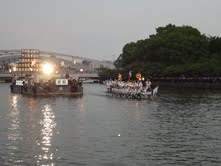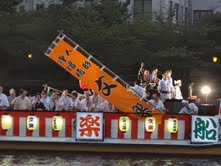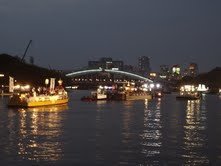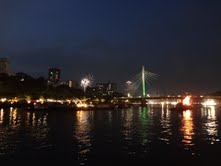Reports Things to See & Do in Osaka at Night
Tenjin Matsuri Festival
 Summertime in Japan is a time for going to the beach, eating watermelon and so-ramen, and especially a time for festivals. In fact, several large and famous festivals span the summer months, starting from the end of June and continuing through to the beginning of August. Osaka also has its share of large scale festivals. The biggest in Osaka and the third most famous in Japan is the Tenjin Festival from July 24-25th. This year I got my chance to participate in this nationally famous event when I received a special invitation to attend the Tenjin Festival Boat Procession, called “Funatogyo.”
Summertime in Japan is a time for going to the beach, eating watermelon and so-ramen, and especially a time for festivals. In fact, several large and famous festivals span the summer months, starting from the end of June and continuing through to the beginning of August. Osaka also has its share of large scale festivals. The biggest in Osaka and the third most famous in Japan is the Tenjin Festival from July 24-25th. This year I got my chance to participate in this nationally famous event when I received a special invitation to attend the Tenjin Festival Boat Procession, called “Funatogyo.”  First of all, what is Tenjin Festival? This festival has been performed for over 1,000 years. Of the many reasons for the festivities, one of them is to honor the posthumous scholar, Michizane Sugawara, also known as “Tenjin.” In the present day festival, the celebration spans two days in July. On the first day, the ceremonies start very early in the morning at Osaka Tenmangu Shrine and continue throughout the day. On the second day, two processions take place, starting on land, called “rikutogyo,” and then by river, called “funatogyo.” During the rikutogyo, 3000 participants parade from Osaka Tenmangu Shrine to the Okawa River at the Tenjinbashi Bridge. The procession then continues on boats in the funatogyo as they travel down the river towards the Hishobashi Bridge. At the same time, worshippers go out to welcome the shrine procession by loading onto boats at Hishobashi Bridge and traveling up the Okawa River towards Tenjinbashi Bridge. It is a really calm ride on the river as worshippers travel up the river on the left side and the Osaka Tenmangu procession travels down the river on the right side, creating a revolving circle between Tenjinbashi and Hishobashi bridges. In this way, everyone gets to see every boat participating on the riverway.
First of all, what is Tenjin Festival? This festival has been performed for over 1,000 years. Of the many reasons for the festivities, one of them is to honor the posthumous scholar, Michizane Sugawara, also known as “Tenjin.” In the present day festival, the celebration spans two days in July. On the first day, the ceremonies start very early in the morning at Osaka Tenmangu Shrine and continue throughout the day. On the second day, two processions take place, starting on land, called “rikutogyo,” and then by river, called “funatogyo.” During the rikutogyo, 3000 participants parade from Osaka Tenmangu Shrine to the Okawa River at the Tenjinbashi Bridge. The procession then continues on boats in the funatogyo as they travel down the river towards the Hishobashi Bridge. At the same time, worshippers go out to welcome the shrine procession by loading onto boats at Hishobashi Bridge and traveling up the Okawa River towards Tenjinbashi Bridge. It is a really calm ride on the river as worshippers travel up the river on the left side and the Osaka Tenmangu procession travels down the river on the right side, creating a revolving circle between Tenjinbashi and Hishobashi bridges. In this way, everyone gets to see every boat participating on the riverway.  On the day of the processions, I was on a boat moored near Hishobashi Bridge with several other boats, waiting for the funatogyo to start traveling down the river. It was my first time ever to see the Tenjin Festival and I did not know what to really expect. I was full of anticipation to find out. When the information came that the shrine procession was now on boats and was on their way, all our boats took off straight away with mine being one of the first. Gradually, all the boats were pulled from the moor, and the welcome party started moving upstream. As our boat moved off, our master of ceremonies for the evening gave commentary and tested passengers in the “Naniwa Nandemo Osaka Kentei,” a test offered for those who want to be certified for knowing A LOT about Osaka’s history and culture. For the first question, our MC pointed out the white barriers surrounded by bamboo that were set at two points on either side of the bridges we would be going under. “What are they,” he asked. Do you know the answer? It is considered bad manners for spectators on bridges to stand over and observe the passing boats carrying gods, so barriers were put up on each side of the bridge for the downstream and upstream traffic, and all boats traveled under these barriers.
On the day of the processions, I was on a boat moored near Hishobashi Bridge with several other boats, waiting for the funatogyo to start traveling down the river. It was my first time ever to see the Tenjin Festival and I did not know what to really expect. I was full of anticipation to find out. When the information came that the shrine procession was now on boats and was on their way, all our boats took off straight away with mine being one of the first. Gradually, all the boats were pulled from the moor, and the welcome party started moving upstream. As our boat moved off, our master of ceremonies for the evening gave commentary and tested passengers in the “Naniwa Nandemo Osaka Kentei,” a test offered for those who want to be certified for knowing A LOT about Osaka’s history and culture. For the first question, our MC pointed out the white barriers surrounded by bamboo that were set at two points on either side of the bridges we would be going under. “What are they,” he asked. Do you know the answer? It is considered bad manners for spectators on bridges to stand over and observe the passing boats carrying gods, so barriers were put up on each side of the bridge for the downstream and upstream traffic, and all boats traveled under these barriers.  As we went down the river, the scene became not unlike a river highway. Traffic flowed on the left and right side of the river, with stage barges and even fire ships parked in the middle of the river along the way. There was even enough room for small emergency craft to speed up and down the river. On the stage boats, there was dancing and Noh performances. We also met the mikoshi along the way. The passengers on these boats were very solemn and prayed to the mikoshi as they traveled down the river. In front of one mikoshi, especially, there was a boat that carried an “omukae ningyo,” a doll that was made to welcome the gods. These dolls are displayed on land and then put on boats preceding mikoshi. The dolls are exquisitely made, and it is said that one doll can cost over millions of yen to make. Also along the way, we saw a Rakugo boat and a bunraku boat. On the bunraku boat, a puppet dressed as a priest rode up front and rang bells as his boat skirted over the water. I smiled when I saw the puppet and heard the sound of the bells. My favorite boats were the Dondoko boats. They would appear very suddenly from around other boats, and I enjoyed watching them the most. The boats were pulled by a team of forty men or boys using paddles. As they passed by, I watched how they rowed the boat. It looked very difficult and tiring, but they never missed a beat and the boat moved smoothly down the river.
As we went down the river, the scene became not unlike a river highway. Traffic flowed on the left and right side of the river, with stage barges and even fire ships parked in the middle of the river along the way. There was even enough room for small emergency craft to speed up and down the river. On the stage boats, there was dancing and Noh performances. We also met the mikoshi along the way. The passengers on these boats were very solemn and prayed to the mikoshi as they traveled down the river. In front of one mikoshi, especially, there was a boat that carried an “omukae ningyo,” a doll that was made to welcome the gods. These dolls are displayed on land and then put on boats preceding mikoshi. The dolls are exquisitely made, and it is said that one doll can cost over millions of yen to make. Also along the way, we saw a Rakugo boat and a bunraku boat. On the bunraku boat, a puppet dressed as a priest rode up front and rang bells as his boat skirted over the water. I smiled when I saw the puppet and heard the sound of the bells. My favorite boats were the Dondoko boats. They would appear very suddenly from around other boats, and I enjoyed watching them the most. The boats were pulled by a team of forty men or boys using paddles. As they passed by, I watched how they rowed the boat. It looked very difficult and tiring, but they never missed a beat and the boat moved smoothly down the river.
When our boat met other passing boats, the MCs on each boat would talk to each other, and sometimes would even give self introductions. Such communication between boats was a new concept for me, and I quite enjoyed watching and listening how the passengers were curious about whom they were passing. Not only that, but our MC would say hello to people watching from the shore, bridges, apartment buildings, and restaurants: “Hello, people up there,” “Hello, people on the bridge,” “Sir, are you alright? Your face is red. Hello!”
The most interesting interaction between boats was the Osaka-jime, a rhythmic clap unique to Osaka. We performed the Osaka-jime several times through the course of the night, inviting other boats, and also commentators and spectators watching from the river shore, to clap with us. Generally, when boats started passing each other, one MC or the other would ask if everyone would participate. Once there was a reply, the following was performed:
MC (in Japanese): Uchimasho!
Everyone: (claps twice, in the rhythm of “chon, chon”)
MC (in Japanese): Mo hitotsu se!
Everyone: (claps twice, in the rhythm of “chon, chon”)
MC (in Japanese): Iwau te sando
Everyone : (claps twice, pause, and claps once more in the rhythm of “chon, chon (ga) chon”)
The third part was always the most difficult because the pause created an uneven rhythm. To get it right, I always said “chon, chon (ga) chon” in my head.
As it started getting dark, fireworks started to spring up from two or three areas around the river’s edge. At first, the fireworks seem to shoot up as a surprise to passing boats, but then they continued to rise and open up in beautiful sparkles from all around us. Finally, on our return trip our boat was caught directly under the finale of whistling and exploding rockets. Showers of gold and copper and balls of purple and green rained on our boat as we continued towards our destination.
When we finally rounded the last fire ship near Hishobashi Bridge, our boat slowly made its way back to the moor from where we started. While during the course of our trip I saw many boats whose passengers were singing, dancing, and playing instruments, I did not feel so uplifted or excited. In fact, as I enjoyed the ride up and down the river and watched the procession, I felt very solemn and quiet. I was surprised by this feeling, but at the same time it seemed natural. Being on a boat in the middle of the river procession gave me a very interesting perspective on this festival. I was thankful to be part of such an experience. Whether watching this festival on a boat or by land, I recommend checking it out. Next year, I would love to see the festivities at Osaka Tenmangu Shrine or even to participate in the funatogyo again. I hope to see you there.
By Haruko Rhoads
The most interesting interaction between boats was the Osaka-jime, a rhythmic clap unique to Osaka. We performed the Osaka-jime several times through the course of the night, inviting other boats, and also commentators and spectators watching from the river shore, to clap with us. Generally, when boats started passing each other, one MC or the other would ask if everyone would participate. Once there was a reply, the following was performed:
MC (in Japanese): Uchimasho!
Everyone: (claps twice, in the rhythm of “chon, chon”)
MC (in Japanese): Mo hitotsu se!
Everyone: (claps twice, in the rhythm of “chon, chon”)
MC (in Japanese): Iwau te sando
Everyone : (claps twice, pause, and claps once more in the rhythm of “chon, chon (ga) chon”)
The third part was always the most difficult because the pause created an uneven rhythm. To get it right, I always said “chon, chon (ga) chon” in my head.
As it started getting dark, fireworks started to spring up from two or three areas around the river’s edge. At first, the fireworks seem to shoot up as a surprise to passing boats, but then they continued to rise and open up in beautiful sparkles from all around us. Finally, on our return trip our boat was caught directly under the finale of whistling and exploding rockets. Showers of gold and copper and balls of purple and green rained on our boat as we continued towards our destination.
When we finally rounded the last fire ship near Hishobashi Bridge, our boat slowly made its way back to the moor from where we started. While during the course of our trip I saw many boats whose passengers were singing, dancing, and playing instruments, I did not feel so uplifted or excited. In fact, as I enjoyed the ride up and down the river and watched the procession, I felt very solemn and quiet. I was surprised by this feeling, but at the same time it seemed natural. Being on a boat in the middle of the river procession gave me a very interesting perspective on this festival. I was thankful to be part of such an experience. Whether watching this festival on a boat or by land, I recommend checking it out. Next year, I would love to see the festivities at Osaka Tenmangu Shrine or even to participate in the funatogyo again. I hope to see you there.
By Haruko Rhoads
- LINK :Tenjin Matsuri Festival
